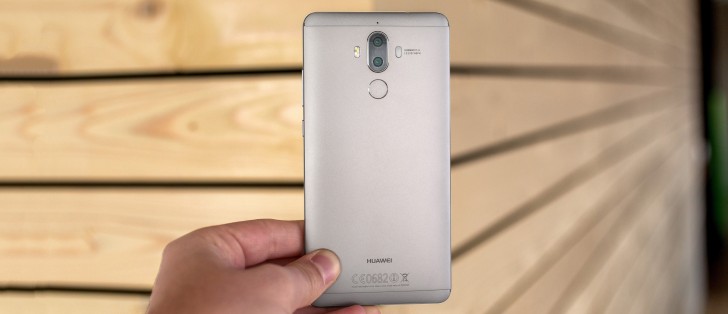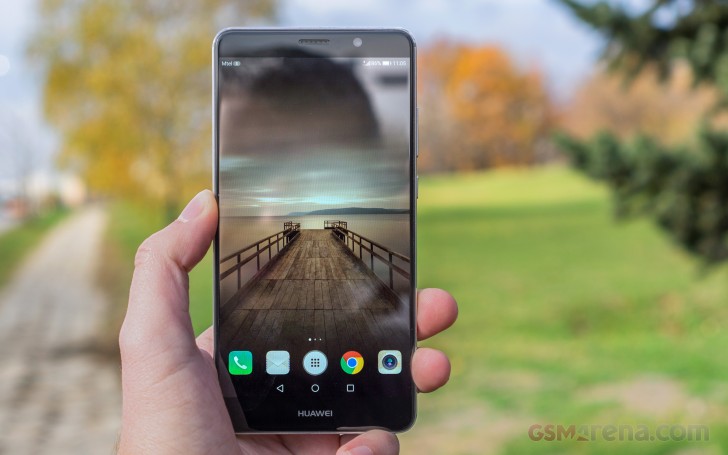Huawei Mate 9 review: Mighty Mate
Mighty Mate

Synthetic benchmarks
The Huawei Mate 9 is powered by the Kirin 960 SoC, developed by the in-house chipmaker HiSilicon. Kirin chipsets have been around for a while now, but there are a lot of firsts that come along with this particular chipset - most notably, new ARM CPU cores and a new GPU.
The main processor within the chipset consists of a quad-core Cortex-A73 cluster clocked at 2.4GHz, plus a quad-core array of the familiar Cortex-A53 cores ticking at 1.8GHz. The Cortex-A73s boast a 30% power efficiency compared to the previous A72 design, while also promising improved performance.

You know the drill - we start with the CPU testing, and that means some GeekBench-ing. In version 4 of the popular benchmark, the Mate 9 easily tops the flagship chart in multi-core. The iPhone 7 Plus' score is 8-9% lower, but the highest-ranked droid - the Snapdragon 821-powered Xiaomi Mi 5s Plus - is behind by a country mile.
In the single-core test the Kryo cores inside Qualcomm's top-of-the-line SoC make up for it, nearly matching the Mate 9's A73s. The iPhone 7's Fusion cores are in a league of their own in single-core computation powers, though.
GeekBench 4 (multi-core)
Higher is better
-
Huawei Mate 9
6112 -
Apple iPhone 7 Plus
5664 -
Xiaomi Mi 5s Plus
4333 -
Google Pixel XL
4152 -
Samsung Galaxy S7 edge (SD 820)
4128 -
LG V20
3890
GeekBench 4 (single-core)
Higher is better
-
Apple iPhone 7 Plus
3473 -
Huawei Mate 9
1898 -
Xiaomi Mi 5s Plus
1815 -
Samsung Galaxy S7 edge (SD 820)
1696 -
LG V20
1590 -
Google Pixel XL
1507
Two versions of Basemark OS II we ran on the Mate 9 (like we've done for a while now), and the Huawei phablet is without competition in the Android world. In Basemark 2.0 the Mi 5s Plus, the Snapdragon version of the Galaxy S7 edge, and the Pixel XL are staying somewhat close, but the Exynos S7 edge lags behind. The difference is more pronounced in the older version of the benchmark, where only the S821 Mi 5s Plus is putting up a fight, barely.
Basemark OS 2.0
Higher is better
-
Apple iPhone 7 Plus
3796 -
Huawei Mate 9
2637 -
Xiaomi Mi 5s Plus
2434 -
Samsung Galaxy S7 edge (SD 820)
2352 -
Google Pixel XL
2281 -
Huawei P9
2068 -
Samsung Galaxy S7 edge
2050
Basemark OS II
Higher is better
-
Huawei Mate 9
3280 -
Xiaomi Mi 5s Plus
2677 -
Huawei P9
2190 -
Samsung Galaxy S7 edge
2107 -
Samsung Galaxy S7 edge (SD 820)
2045
The Antutu 6 score isn't as mind-blowing - actually the Mate 9 places last of this year's flagships - a rather odd development.
AnTuTu 6
Higher is better
-
Apple iPhone 7 Plus
173110 -
Xiaomi Mi 5s Plus
155185 -
Google Pixel XL
141186 -
Samsung Galaxy S7 edge (SD 820)
132849 -
Samsung Galaxy S7 edge
129229 -
Huawei Mate 9
122826 -
Huawei P9
98069
We expected the new Mali-G71 GPU to shine, and for a brief moment there it almost did - in Basemark X. Inching ahead of the Mi 5s Plus, it did top yet another of the benchmark charts, though, there is nothing spectacular about its numbers.
Basemark X
Higher is better
-
Huawei Mate 9
36519 -
Xiaomi Mi 5s Plus
36062 -
Samsung Galaxy S7 edge (SD 820)
32160 -
Google Pixel XL
30861 -
Samsung Galaxy S7 edge
28480 -
Huawei P9
16942
On to GFXBench and the framerates, the Mate 9 didn't quite leave us raving, posting average scores across the board. In the most demanding test - the OpenGL ES 3.1 Car scene, the Mate 9 managed 14fps in the onscreen part, while the S821 Mi 5s Plus excels with a 19fps frame rate. Meanwhile, the Pixel XL and the S820 S7 edge did 11 and 10fps respectively, despite having to render 1.78 times the number of pixels.
In the offscreen part of the same test, which puts all devices on a level 1080p field, the Adreno 530 clearly shows its superiority over the Mate 9's Mali-G71.
GFX 3.1 Car scene (offscreen)
Higher is better
-
Google Pixel XL
19 -
Samsung Galaxy S7 edge (SD 820)
18 -
Xiaomi Mi 5s Plus
18 -
Samsung Galaxy S7 edge
15 -
Huawei Mate 9
13 -
Huawei P9
6.5
GFX 3.1 Car scene (onscreen)
Higher is better
-
Xiaomi Mi 5s Plus
19 -
Huawei Mate 9
14 -
Google Pixel XL
11 -
Samsung Galaxy S7 edge (SD 820)
10 -
Samsung Galaxy S7 edge
7.8 -
Huawei P9
7.1
You would think then that the Mate 9 would be defeated in Basemark ES 3.1, but no - it actually claims the top once again. Well, save for that iPhone 7 Plus, which makes us wonder just how comparable the cross-platform benchmark results are. Well, maybe it's that good.
Basemark ES 3.1 / Metal
Higher is better
-
Apple iPhone 7 Plus
1517 -
Huawei Mate 9
794 -
Samsung Galaxy S7 edge
733 -
Google Pixel XL
626 -
Samsung Galaxy S7 edge (SD 820)
624 -
Xiaomi Mi 5s Plus
538 -
Huawei P9
341
So, the conclusions we can draw about the Mate 9's performance is that it has a really fast CPU in both single-thread and multi-core applications and a GPU that's still not quite there. Or rather, a GPU that is still waiting for applications that can benefit from the Vulkan graphics API support.
Reader comments
- Malalas
- 07 Mar 2024
- 3pS
Yeah, go ahead, buy
- vino
- 18 Apr 2022
- PIu
Bought on April 2017, still using till now. Its been 5 years to be exact. Long lasting.
- Anthonhio
- 17 Nov 2018
- F0x
The silver color is very nice in short Huawei mate there all nice